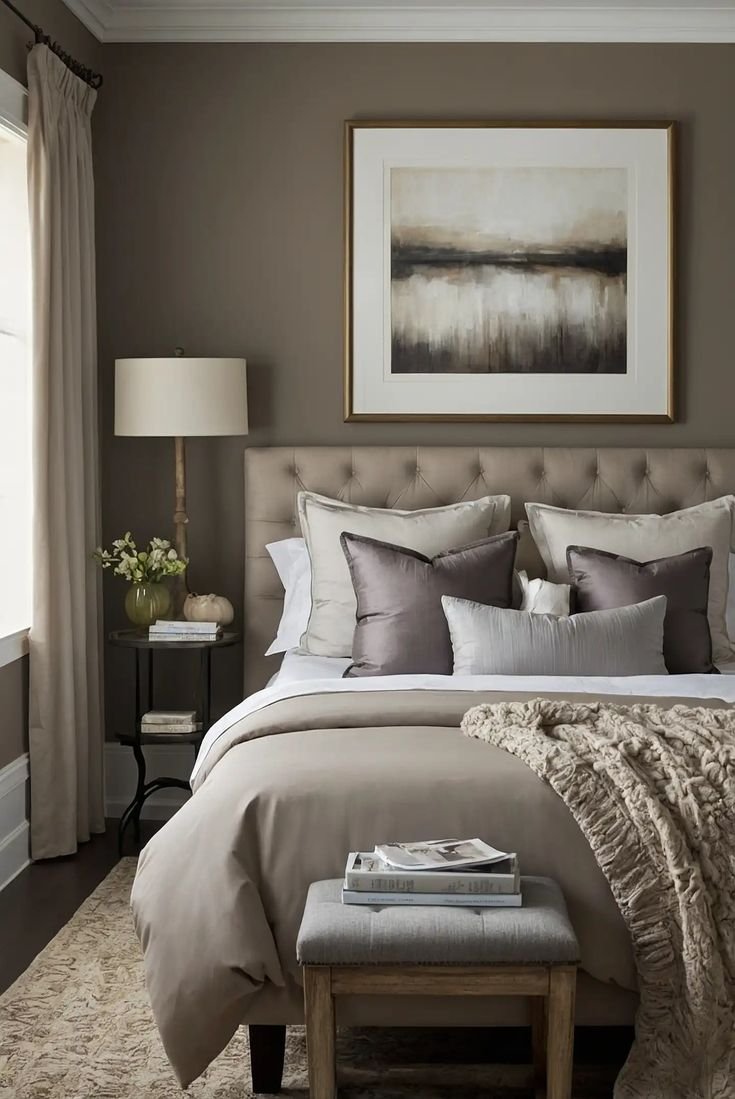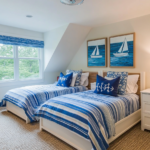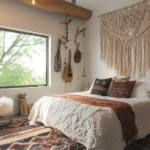When you’re working with a small bedroom, it’s easy to feel boxed in—literally. Limited space often feels cramped, dark, or cluttered. But here’s the thing: color can change everything.
The right paint shade can visually expand your room, bring in warmth or light, and even influence your mood. That’s the magic of color—it sets the tone (pun intended) and makes your space feel more “you.” And yes, the best part? You don’t need to knock down a single wall.
So if your bedroom’s tight on square footage but big on potential, you’re in the right place. Let’s explore 19 stunning paint colors that are practically made for small bedrooms.
1.Soft Neutrals: The Subtle Space Expanders
Warm White
You might be wondering, “Is white too basic?” Not at all—especially when it’s a warm-toned white.
Warm whites (think creamy rather than clinical) reflect natural light beautifully without making the room feel cold or stark. They create an airy, fresh canvas that complements everything—from wooden furniture to bold accent pieces.
Use this if you want a clean slate that still feels cozy and not sterile.
Pale Beige
Beige gets a bad rep sometimes, but it’s making a serious comeback—especially in small spaces.
Pale beige adds gentle warmth while keeping things neutral. It works with both cool and warm décor and doesn’t overpower the room. Plus, it creates that timeless, minimalist vibe so many people love.
Pair it with textured throws and soft lighting for a hotel-like retreat.

2.Calm & Cool Colors: Tranquility in Every Corner
Light Gray
Ever felt instantly calm when walking into a soft gray room? That’s not a coincidence.
Light gray is cool, clean, and ultra-sophisticated. It offers just enough color to define the room without overwhelming it. In fact, it’s one of the best choices if you’re working with limited natural light.
Choose a warm or cool undertone based on your furniture for a cohesive look.
Sky Blue
Small rooms and soft blues are a match made in heaven.
Sky blue instantly opens up a room, bringing a serene and airy atmosphere. It’s like giving your walls a breath of fresh air. Plus, it pairs beautifully with white trim, rattan accessories, and plants.
Want to make your room feel like a coastal retreat? This shade is your go-to.
Sage Green
Why does sage feel so calming? Because it mimics nature.
Sage green has the power to ground a room while keeping it light. It’s earthy yet soft, making it perfect for a bedroom where you want to wind down. It adds just the right amount of character without screaming for attention.
Pair it with beige or off-white textiles for a soothing palette.

3.Moody Hues That Still Work in Small Spaces
Charcoal Gray
Yes, dark shades can work in small rooms—if done right.
Charcoal gray adds drama and depth, especially when you pair it with light bedding and mirrors to reflect light. It makes the space feel rich, intimate, and enveloping. This is perfect if you want that “cozy cocoon” effect.
Just keep furniture light or minimal to balance out the boldness.
Navy Blue
Navy in a small bedroom? Absolutely!
Navy blue provides a crisp, elegant backdrop that’s surprisingly versatile. It can be nautical, modern, or even vintage depending on your accessories. And despite being dark, it recedes visually, making walls feel farther apart.
Add brass fixtures or warm wooden tones for contrast.
Forest Green
Looking for something bold yet grounded? Forest green is deeply calming and surprisingly versatile.
This lush shade brings a dramatic flair without feeling overwhelming. It works best with lots of white or beige accents, like a crisp duvet or pale wood floors. The contrast makes everything pop—and makes your room feel designer-curated.
It’s the paint color equivalent of a velvet throw—luxurious and warm.

4.Happy Midtones That Add Life Without Clutter
Blush Pink
Not just for kids’ rooms anymore—blush is all grown up.
Blush pink offers a subtle, grown-up warmth that’s still light enough to open up the room. It flatters all skin tones, looks stunning in golden hour lighting, and pairs with everything from gray to green.
Add in some copper or rose gold accents, and you’ve got a truly chic sanctuary.
Dusty Lavender
Lavender may sound bold, but when muted into a dusty hue, it’s absolutely dreamy.
This shade gives your room a soft, romantic feel without going too sweet. It pairs beautifully with grays, creams, and even dark woods. Perfect if you want a unique but tranquil color.
And yes, it makes an excellent backdrop for candlelight and calm.
Muted Mustard
Don’t scroll past just yet—this one’s special.
Muted mustard brings in just enough energy without being loud. Think of it as a deep golden beige. It adds warmth, style, and a bit of vintage flair that works beautifully in small, naturally lit spaces.
Pair with olive green, navy, or rust for a well-curated look.

5.Crisp & Cool Whites That Still Have Personality
Alabaster
If you’re after something between warm white and soft ivory, Alabaster is your answer.
This shade from Sherwin-Williams is famous for a reason. It’s bright but never sterile, soft but not yellow. It works wonders in compact bedrooms where you want brightness without starkness.| Alabaster is ideal if you love a minimalist or Scandinavian aesthetic.
Chantilly Lace
Think of this one as the crispest, cleanest white in the room.
Chantilly Lace by Benjamin Moore is a favorite among designers. It reflects light beautifully and offers a clean slate for literally any kind of décor. It’s perfect for ultra-modern spaces or to balance dark wood tones.
Use this in rooms with great natural light for a gallery-like effect.

6.Unexpected Favorites That Add Style Instantly
Greige
Can’t decide between gray and beige? You don’t have to.
Greige is the perfect middle ground that adapts beautifully to different lighting throughout the day. In the morning, it might look warm and beige; in the evening, cool and soft gray. That kind of chameleon effect makes it perfect for small bedrooms.
Add textured fabrics and metallic accents for elevated style.
Soft Terracotta
Who says earth tones can’t work in tiny rooms?
A soft terracotta creates instant warmth and makes the room feel grounded yet fresh. It’s not too orange, not too brown—just a gentle, sun-baked clay tone. Ideal for creating a cozy, down-to-earth atmosphere.
Try pairing it with woven textures and plants for an earthy, boho vibe.
Light Taupe
Taupe may sound boring, but in reality, it’s a quiet star.
Light taupe is subtle, sophisticated, and endlessly versatile. It brings a bit more depth than beige, without veering into dark territory. It plays well with pastels, brights, and darker tones alike.
Want something timeless but not white? Light taupe is your best bet.

7.Pastels That Don’t Feel Like a Nursery
Soft Peach
Peach doesn’t have to scream 1980s bathroom—modern versions are muted and elegant.
Soft peach adds gentle warmth and bounce to the room. It reflects a golden hue in sunlight and makes even small rooms feel cheerful and bright. It works particularly well with white and gold accents.
It’s ideal for adding a bit of glow without being over-the-top.
Powder Blue
Yes, it’s classic—but also timeless.
Powder blue is calm, clean, and always fresh. In small bedrooms, it has a subtle uplifting effect that feels like a breath of fresh air. It’s a great alternative to white if you want more personality without sacrificing brightness.
Use it with white furniture or navy accents for a beachy, clean aesthetic.

8.Bonus: Paint Color Pairing Tips for Small Bedrooms
Want to go beyond just one color? You can! But you’ll want to keep it cohesive.
Here are a few ideas for color combinations that work beautifully in small bedrooms:
| Main Color | Accent Wall or Trim Color |
|---|---|
| Light Gray | Navy Blue |
| Sage Green | Soft White |
| Blush Pink | Charcoal Gray |
| Alabaster | Dusty Lavender |
| Greige | Soft Peach |
A bold accent wall in a coordinating hue can add dimension without closing in the space. You can also add depth by painting ceilings a slightly lighter shade than the walls.

9.Final Thoughts: Your Color, Your Comfort
So, which color is calling your name?
Choosing the best paint color for a small bedroom isn’t about following strict rules—it’s about creating a space that reflects how you want to feel in it. Whether that’s calm and peaceful, bright and airy, or moody and stylish, the right color will get you there.
Remember, small bedrooms have big potential. A single can of paint can completely change how your space looks and lives. So go ahead, pick that dreamy shade—and give your bedroom the glow-up it deserves.
Got a favorite on this list? Or thinking of a bold combo of your own? Trust your gut. After all, it’s your space—and you’re the one waking up in it every morning.
Let your walls speak your style—one brushstroke at a time.




